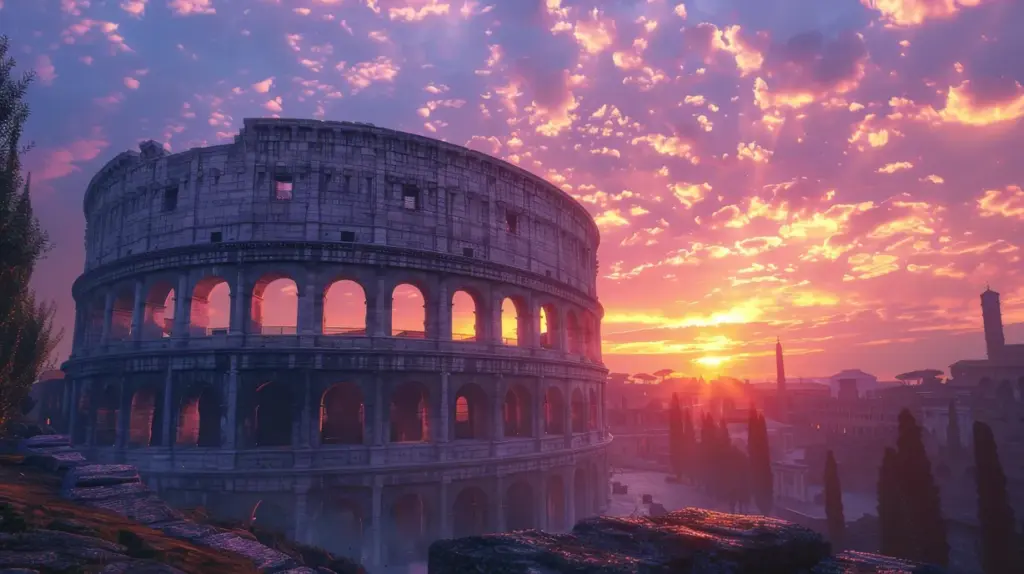Rome, the Eternal City, is steeped in history and serves as a living museum that attracts millions of tourists each year. This ancient city is a treasure trove of historical sites that span across centuries, making it one of the most enriching destinations for history enthusiasts. From remnants of the Roman Empire to Baroque masterpieces, Rome offers an array of historical attractions that are sure to captivate any visitor.
The Colosseum
The Colosseum, also known as the Flavian Amphitheatre, is perhaps the most iconic symbol of Rome. This massive stone amphitheater could hold between 50,000 to 80,000 spectators and was used for gladiatorial contests and public spectacles such as animal hunts, executions, and dramas based on classical mythology.
Visitors can take a guided tour to learn about the history of the Colosseum, its architectural innovations, and its cultural significance. The structure itself is awe-inspiring, with its intricate arches and detailed Roman engineering. Make sure to spend some time exploring the underground chambers where gladiators and animals were kept before contests.
Don’t forget to bring your camera; the Colosseum offers stunning photo opportunities, especially when it’s illuminated at night. This monumental structure is a must-visit for anyone interested in the grandeur of ancient Roman civilization.
The Roman Forum
The Roman Forum was the center of public life in ancient Rome, serving as a marketplace, gathering spot, and the location for important religious and political activities. Today, it stands as one of the most significant archaeological sites in the world.
Visitors to the Roman Forum can walk through the ruins, which include temples, basilicas, and governmental buildings. Some of the most noteworthy structures are the Temple of Saturn, the Arch of Septimius Severus, and the Curia Julia. Informational plaques and guided tours can provide context and insight into the daily life in ancient Rome.
As you explore, it’s easy to imagine what life was like during the height of the Roman Empire. The Forum is a testament to the architectural prowess and societal complexity of ancient Rome, making it an essential stop for any history buff.
The Pantheon
The Pantheon is one of the best-preserved buildings from ancient Rome and remains in continuous use throughout its history. Originally built as a temple dedicated to all the gods, it was later converted into a Christian church.
The Pantheon’s most remarkable feature is its massive dome, an architectural marvel that has influenced building designs around the world. The oculus at the center of the dome lets in natural light, creating a dramatic effect that enhances the architectural beauty of the interior space.
Inside, visitors can admire the grand coffered ceiling and the tombs of notable figures such as the artist Raphael. The Pantheon’s harmonious proportions and expertly crafted design make it a highlight of any visit to Rome.
St. Peter’s Basilica
St. Peter’s Basilica is one of the largest and most renowned churches in the world, located in the Vatican City. It stands on the site believed to be the burial place of St. Peter, one of Jesus’s apostles and the first Pope.
Construction of the current basilica began in the early 16th century and involved contributions from renowned architects such as Michelangelo, who designed the iconic dome. The basilica’s opulent interior features stunning mosaics, intricate marble works, and Michelangelo’s famous sculpture, ‘Pietà.’
Visitors can climb to the top of the dome for panoramic views of Vatican City and Rome. The Vatican Museums, including the Sistine Chapel, are also nearby and well worth a visit to further immerse yourself in the history and art of the Vatican.
The Vatican Museums
The Vatican Museums house one of the world’s most impressive collections of art and historical artifacts. Founded by Pope Julius II in the early 16th century, the museums comprise over 20,000 works on display and offer a unique insight into the cultural and religious history of the Vatican.
Highlights include the Raphael Rooms, decorated with stunning frescoes, and the Gallery of Maps, which showcases exquisite cartographic art. The Sistine Chapel, with Michelangelo’s masterpiece ceiling, is a must-see and often leaves visitors in awe of its artistic grandeur.
Plan to spend several hours exploring the Vatican Museums to fully appreciate the wealth of art and history contained within its walls. Guided tours are available and highly recommended to gain a deeper understanding of the significance of each exhibit.
Castel Sant’Angelo
Originally built as a mausoleum for Emperor Hadrian, Castel Sant’Angelo has served various purposes over the centuries, including a fortress, papal residence, and prison. Today, it stands as a museum offering fascinating insights into its multifaceted history.
Visitors can explore the castle’s many rooms, including the papal apartments and the Armory Hall, where ancient weapons are displayed. The rooftop terrace provides stunning views over the Tiber River and the city of Rome, making it a perfect spot for photographs.
The Castel’s rich history and unique architecture make it a captivating stop for anyone interested in Rome’s past. It also hosts exhibitions and cultural events throughout the year, adding to its appeal.
The Catacombs
The Catacombs of Rome are an extensive network of underground burial sites used by early Christians. These eerie and fascinating tunnels offer a unique glimpse into Rome’s early Christian history and the persecution faced by early believers.
Visitors can take guided tours of several catacombs, including those of San Callisto and San Sebastiano. These tours provide insights into the significance of the catacombs and the extraordinary efforts made to preserve early Christian culture.
The catacombs also feature ancient frescoes and inscriptions that shed light on the beliefs and lives of those who were buried there. Exploring these underground labyrinths is a memorable way to connect with a lesser-known aspect of Rome’s vast historical tapestry.
Rome is a city where history comes alive at every corner. Each of these historical sites offers a unique experience, providing a window into the city’s rich and varied past. Whether you’re wandering through ancient ruins or marveling at Renaissance art, Rome’s historical treasures are sure to leave a lasting impression.



